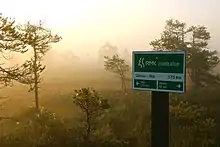State Forest Management Centre
State Forest Management Centre (Estonian: Riigimetsa Majandamise Keskus, abbreviated RMK) is Estonian state institution which focuses mainly on forest management in Estonia, but also seed and plant management, timber marketing, land management, nature conservation, visitor management and nature education.[1]


RMK’s forestry duties include the growing and guarding of the state forest, planting and growing of new forest, organising forestry works and sale of timber. RMK maintains forest roads and drainage systems.
Forestry, Logging, and Controversies
In 2012, Estonia had forests that covered 48% of the land, and is an environment unique in Europe.[2] However recent years have seen a substantial increase in logging, and logging occurs not only nationwide in private land, but even in supposedly protected national parks.[3] Estonia needs to cut significantly less forest to retain biodiversity and meet the country's carbon sequestration goal,[4] but it is increasing, and in 2022 the State Forest Management Center reported a record profit of 1.4 billion euros.[5]
The European Commission has launched a court case against Estonia for logging forest in protected areas, causing the country to risk a 100,000 euro per day fine.[6] Some NGOs are also taking the country to court.[7]
In addition, several Estonian news outlets have reported the on Ministry of the Environment and the State Forest Management Centre “misleading” the public about logging in the country.[3]
The RMK is both responsible for protecting the nation's forests, as well as overseeing exploitation of the resources, leading to a natural conflict of interest within the Estonian government.[3] One example is a situation where the director-general of the Environment Board resigned shortly after temporarily pausing logging to protect nesting birds.[3]
Comparison to cultural values
Culturally, Estonians are a people who value their environment and wish to protect it, with national stories that integrate forests such as the partisan Forest Brothers; or the traditional sacred trees, forests and groves;[8] and exemplified in this quote by ex-president Lennart Meri:
“Our natural environment… is unique in Europe. This is a resource we are not yet conscious of, that we more often than not still have to learn to use [and] we could make huge and incorrigible mistakes when looking for immediate profit.
“Let us be masters in our own country, not avaricious colonists, who leave a ravaged country behind them… The export of raw timber is a sign of a bad master. If we add the wasted felling areas and damaged ecosystem, we can see that there is not much left of our advantages.”[2]
-- the late Estonian president Lennart Meri in a speech on 24 February 2000.
Other RMK Roles
RMK provides as varied opportunities as possible for recreation, while not harming the biota there. RMK builds hiking trails, maintains accommodation facilities, marks scenic recreational areas, and prepares camping sites and campfire places. Besides the creation of recreational opportunities, RMK also provides education about the natural environment.
RMK’s plant and seed management area grows tree sets and ensures Estonia has a sufficient reserve of forest seed.
RMK consists of Sagadi Forest Centre, Elistvere Animal Park and, as of 2014, also the Põlula Fish Farm. One to two year old juvenile salmon are grown in Põlula, in order to increase the biodiversity of Estonian rivers.
The RMK was established in 1999.
References
- "About RMK". rmk.ee. Retrieved 27 March 2020.
- "President of the Republic on the 82nd Anniversary of the Republic of Estonia in the Estonia Hall". vp1992-2001.president.ee. Retrieved 2023-05-31.
- Millington, David (2022-04-11). "The war on Estonian forests". Estonian World. Retrieved 2023-05-31.
- "Kas metsanduse arengukava kaitseb Eesti metsi?". Bioneer (in Estonian). 2021-12-14. Retrieved 2023-05-31.
- ERR, Marko Tooming | (2023-03-20). "RMK 2022 profit €153 million". ERR. Retrieved 2023-05-31.
- "Estonia looking at €100,000 fine for clearcutting protected areas". Estonian news. 2021-07-27. Retrieved 2023-05-31.
- Tambur, Silver (2022-06-28). "An NGO takes the Estonian government to court over logging in protected areas". Estonian World. Retrieved 2023-05-31.
- "Sacred Groves And Trees Of Native Estonians: Traditional Behavioural Normatives". www.maavald.ee. Retrieved 2023-05-31.